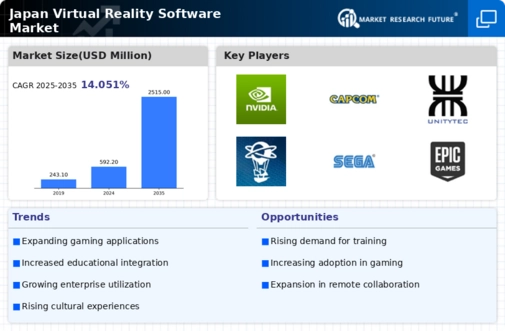The Japan Virtual Reality Software Market has seen substantial growth and innovation in recent years, driven largely by advancements in technology, increasing demand for immersive experiences, and a rapidly expanding user base across various sectors like gaming, education, healthcare, and enterprise applications. As the market grows, competition escalates, with several key players establishing a strong presence and continuously striving to develop cutting-edge solutions.
Understanding the competitive landscape is crucial for stakeholders as they navigate the complexities of this dynamic environment, characterized by constant technological advancements and shifts in consumer preferences. Companies are focusing on enhancing user experience through improved hardware-software integration while also tapping into local cultural nuances, which play a significant role in shaping consumer behavior in Japan's unique marketplace.Valve has successfully cemented its position within the Japan Virtual Reality Software Market by leveraging its significant strengths and market presence.
The company’s commitment to quality content and a robust ecosystem has enabled it to deliver a range of virtual reality platforms and gaming experiences that resonate with local consumers. The strength of Valve lies in its established relationships with content developers and a vibrant community that drives user engagement and interaction. The company's strategic investments in virtual reality technologies and its focus on providing high-quality immersive experiences have solidified its presence in Japan.
Furthermore, Valve’s compatibility with various VR hardware products enhances its offerings and allows it to cater to a diverse audience seeking advanced virtual reality experiences.NVIDIA has emerged as a key player in the Japan Virtual Reality Software Market by offering a comprehensive suite of products and services that cater to the high-performance demands of virtual reality applications.
Known for its cutting-edge graphics processing units and powerful computing capabilities, NVIDIA provides essential technology that powers many virtual reality platforms in Japan. The company’s strengths include its superior graphics performance, robust developer support, and a wide array of partnerships with leading technology firms, which together facilitate a rich ecosystem for VR development.
NVIDIA’s presence has been further bolstered by strategic mergers and acquisitions that have expanded its portfolio and fortified its market position. By continuously innovating and adapting its offerings to meet the specific needs of the Japanese market, NVIDIA plays a crucial role in defining the standards of virtual reality experiences in the region, making significant contributions to both consumer and enterprise sectors.























Leave a Comment